Is there a more advantageous time of day to fly if you want to avoid cancellations or delays due to summer thunderstorms?
Summer is here – and with it comes afternoon thunderstorms. Heating during the day combined with moist air creates the cycle for cumulus clouds, some of which grow into thunderstorms.
These can disrupt flights because flying through or landing in thunderstorms can be hazardous. The high winds, turbulence and potential microbursts within thunderstorms make them something that pilots avoid.
Many airlines use a hub-and-spoke operation, where large numbers of flight arrive into a city, swap passengers and cargo, then depart. The effect of thunderstorms in these spots can severely disrupt an airline’s operation.
Cities like Atlanta, Chicago, Dallas, Houston, Charlotte, New York, Washington, Los Angeles, San Francisco, Amsterdam and London serve as large international hubs, connecting travelers to their domestic final destinations. So when the thunderstorms arrive over a hub city, the effects are felt for hours or days.
What happens if a hub is shut down?
Loss of a hub causes airlines to shift to their “irregular ops” plan. Their dispatch offices work to get planes and passengers back to the normal schedule as quickly as possible, but there are multiple hurdles to clear.
Flight crew duty time, aircraft maintenance schedules and available reserve crews are just a few of the considerations. Dispatch teams also have to think about rebooking passengers and…




























































